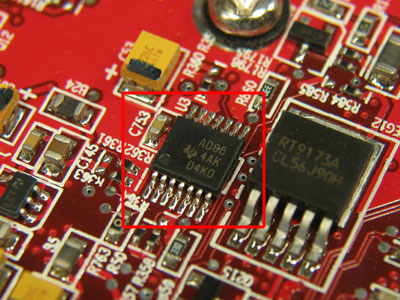Guide to Video BIOS flashing |
|
Introduction

The video is BIOS is a small piece of code (typically <64 KB), which is stored inside a small chip on your video card. When the VGA card receives power, the BIOS is loaded into system memory and immediately executed by the CPU.
On startup, the BIOS initializes the video card:
- Initialize the GPU
- Detect number of memory chips, chip size, access mode
- Enable memory access and set proper timings
- Detect if external devices (analog VGA, DVI, TV-out) are connected and enable them
- Set core and memory clock
- Enable power management
- Set fan speed (if supported by the board)
Once you boot into Windows, the display driver takes over all video functions and the BIOS is no longer used. However, it remains accessible for execution. Actually, manufacturers like ATI added a handful of functions which can be invoked from within Windows, for example to change power management settings on a mobile GPU.
Why flash the BIOS?
Originally, the video BIOS was stored in a ROM (Read Only Memory) and could not be replaced. Nowadays it is located in a flash memory chip (that's why it's called 'flashing').The reason for this move was that like every other piece of software, the BIOS had programming errors, or an issue was detected in the hardware for which a workaround had to be found. So the manufacturers just gave out an updated BIOS to a customer to fix the issue.
The more interesting use is to mod cards. For example, on the X800 Pro VIVO you can unlock additional pipelines by changing the BIOS. How so? Inside the BIOS is a small block of information which tells the GPU how many pipelines it should run at. If you replace the original BIOS with a BIOS which tells the GPU "16 Pipelines!" .. well, then you are running 16 pipelines.
Another good use is to change the default clocks of the card. As you remember from above, the BIOS sets the core and memory clock. On the last page of this article we will cover the different BIOS editors and their use.
Sometimes a new BIOS increases performance as well. However, my personal experience is that this difference is rather small. However, if you do upgrade your video BIOS for this reason, make sure you run benchmarks before and after.
Apr 17th, 2025 18:02 EDT
change timezone
Latest GPU Drivers
New Forum Posts
- SK hynix A-Die (Overclocking thread) only for RYZEN AM5 users (57)
- Need advice RAM for Asus Maximus hero z890 + core ultra 7 265k (37)
- Tried installing 576.02 - installer window disappears (19)
- 3DMARK "LEGENDARY" (301)
- Rtx5070 lost 2%-5% performance after last driver 576.02. (1)
- AAF Optimus Modded Driver For Windows 10 & Windows 11 - Only for Realtek HDAUDIO Chips (427)
- Looking for a rolling workbench recommendation (2)
- RX 9000 series GPU Owners Club (360)
- Windows 11 fresh install to do list (39)
- What are you playing? (23388)
Popular Reviews
- G.SKILL Trident Z5 NEO RGB DDR5-6000 32 GB CL26 Review - AMD EXPO
- ASUS GeForce RTX 5060 Ti TUF OC 16 GB Review
- NVIDIA GeForce RTX 5060 Ti PCI-Express x8 Scaling
- ASUS GeForce RTX 5080 TUF OC Review
- Palit GeForce RTX 5060 Ti Infinity 3 16 GB Review
- DAREU A950 Wing Review
- ASUS GeForce RTX 5060 Ti Prime OC 16 GB Review
- Zotac GeForce RTX 5060 Ti AMP 16 GB Review
- MSI GeForce RTX 5060 Ti Gaming OC 16 GB Review
- MSI GeForce RTX 5060 Ti Gaming Trio OC 16 GB Review
Controversial News Posts
- NVIDIA GeForce RTX 5060 Ti 16 GB SKU Likely Launching at $499, According to Supply Chain Leak (182)
- NVIDIA Sends MSRP Numbers to Partners: GeForce RTX 5060 Ti 8 GB at $379, RTX 5060 Ti 16 GB at $429 (127)
- Nintendo Confirms That Switch 2 Joy-Cons Will Not Utilize Hall Effect Stick Technology (105)
- Over 200,000 Sold Radeon RX 9070 and RX 9070 XT GPUs? AMD Says No Number was Given (100)
- Nintendo Switch 2 Launches June 5 at $449.99 with New Hardware and Games (99)
- NVIDIA Launches GeForce RTX 5060 Series, Beginning with RTX 5060 Ti This Week (95)
- Sony Increases the PS5 Pricing in EMEA and ANZ by Around 25 Percent (85)
- NVIDIA PhysX and Flow Made Fully Open-Source (77)